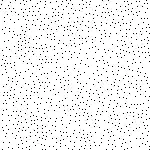What you want to do is take advantage of the fact that a pseudo-random number generator that uses a seed will reproduce the same "random" set of numbers every time. You can read a bit about them at https://en.wikipedia.org/wiki/Random_seed
Given an area for input, find a way to create a seed from that area's information that gives you a unique seed for each area. It might be based on the area's coordinate for example.
Given a seed, when you want to generate your procedural points for the area you set the seed, and create your set of point coordinates from a sequence of random numbers made from the seed.
The only thing to be careful with is that you must use the random generator to generate your sequence the same time every time to ensure repeatability.
A nice twist of this is that you can have a "master seed" for your world that is used to generate each area seed. So given a "master seed", you can recreate an entire unique world in a reproduce-able way. I assume this is how Minecraft works with world seeds.
I just saw the image you uploaded, which sort of clarifies a few things. My answer isn't necessarily answering exactly how you will generate those points, but how you will ensure that procedurally generated points will be reproduceable every time you need to generate them.

